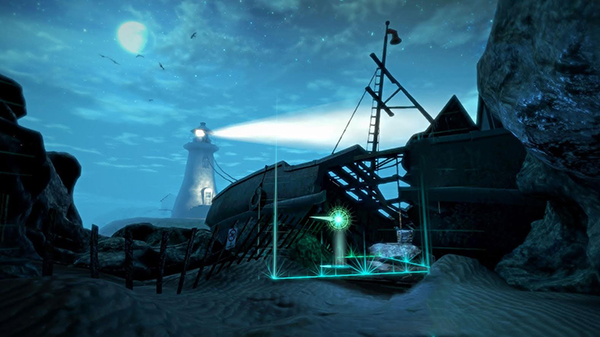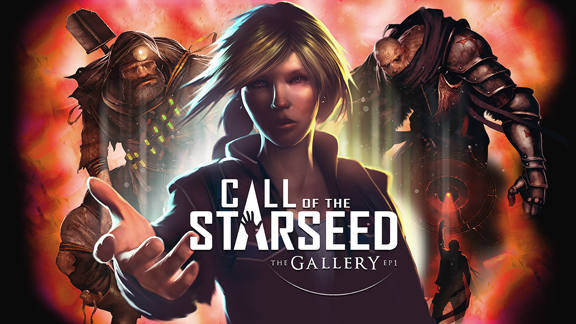Cloudhead Games Addresses Physical Space Limitations Using Blink VR Technology At PAX Prime
One of the biggest problems facing the VR industry is the user experience -- specifically, dealing with the issue of limited physical space. If a game puts you into a large open world environment, for example, you need to be able to explore it, but to date, users have been limited to traversing a small physical space.
Enter Cloudhead Games, a small development team in the process of developing its first episodic VR game on the HTC Vive titled The Gallery. In addition to game development, the team is also developing what it believes to be the best solution to prevent nausea in the VR space, called Blink.
Fast Travel
As the name suggests, the best way to represent Blink is a quick teleport of sorts from one place to another in VR. By pressing and holding down the thumbpad on the Vive's left-handed controller, an illuminated circle appears on the ground. By moving your head up or down, you can change its distance from your character, telling the game where you want to travel within a decent range. In addition, the circle also contains an arrow, which indicates the direction the player will be facing once Blink is activated.
To simulate how it works, Joel Green, a producer and audio director at the studio, showed four pedestals with jars at the corners of the virtual space. Then, he expanded the area, adding more jars in what seemed to be unreachable places due to the sensor's limits. With Blink, I can just look at a location near the intended target and then teleport to it, reeling it in to my interactive surroundings.
If you played Myst, you have an idea of how Blink works. Similar to the classic game, the world is separated into small areas that have their own pieces of interaction. Those looking for realism will be disappointed due to its slide-like transitions, but the fact is that it works well in the demo.
There's also an advanced version of Blink available in the game. I still had to press the thumbpad to activate the Blink circle, but moving my thumb around the pad while it was pressed down brought up an additional box around the initial marker. This outlines the area where you can move around after Blink is activated.There are times when I had to use the normal version of Blink a few times to reach an object just out of bounds, and the advanced mode allows the player to make minor adjustments to make the Blink movement as accurate as possible.
To Fit A Room
Vive utilizes two sensors place on opposite corners of the room to create a virtual space of interaction in a VR game. When you approach the boundary of space, you see a series of illuminated horizontal lines, indicating that you are reaching the end of the sensors' coverage area, which happens to be a wall in the physical world.
Get Tom's Hardware's best news and in-depth reviews, straight to your inbox.
Using Blink in the space provided means that a game is no longer restricted to the Vive's physical boundary limitations. Up to this point, most of the demos I've played have been built within the confines of the sensors. Obviously, there are added details off in the distance, but you would never be able to reach them. Blink overcomes that hurdle so developers can create a large world that is fully explorable in a small room.
After the jar demo, I played the team's game. Call of the Starseed is the first episode in the title, and it featured a beachside environment, littered with a camp, a large boat washed ashore and a habitable cave. Thanks to Blink, I could easily explore this large area piece by piece and interact with objects when they were near me.
The game had a few other interesting features as well, such as accessing my backpack inventory by mimicking the gesture of pulling it over my shoulder, shooting a few bells with a flare gun, and testing the game's binaural audio abilities by putting a cassette recording next to my virtual ears.
However, there were times when Blink would bring me too close to the side of a wall, essentially placing me halfway between the intended path and inside a rock face. However, when that happens, the system will see the error and will eventually reset the player to a previous location.
Showing Promise
Even with all of its abilities, Blink still needs more work. There were moments in the game that required the use of the side buttons on the Vive controllers. Even if I didn't press the thumbpad, Blink would activate, and I would unexpectedly be transported to a nearby area. Also, the immersion factor breaks down when you reach the virtual borders, as indicated by bright horizontal lines that show that the physical wall is present, specified by the Vive. Obviously, this was created so that the user wouldn't constantly hit it during gameplay, but it's not exactly subtle.
Still, credit must be given to Green and the rest of the Cloudhead team. Like other VR game developers, they are wading into uncharted waters, but these developers in particular are also working on new features that could enhance not only their game, but other VR titles in the future.
Even though the demo I tried was on the Vive, I was told that Oculus has also seen the work, and just like the Vive engineers, the idea was met with excitement. As for the spread of Blink to other games, it won't happen any time soon. The team has no plans to license the product for now, and the idea of just providing it as an open-source offering would cripple the company's financial foundation more than improve its exposure to more fans.
Initially, The Gallery was supposed to be one full game instead of an episodic title. The change came about as part of the team's goal of preparing for any new improvements coming to VR in the next few months. For now, the team will return to its normal operations of dividing the work between Blink and the game's various episodes. Right now, it looks like Blink isn't the one-size-fits-all technology that it could be for VR, but it's one of the many ways developers are being proactive and creating their own mechanics to make fantasy a virtual reality.
Follow Rexly Peñaflorida II @Heirdeux. Follow us @tomshardware, on Facebook and on Google+.
Rexly Peñaflorida is a freelance writer for Tom's Hardware covering topics such as computer hardware, video games, and general technology news.


